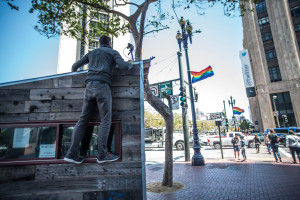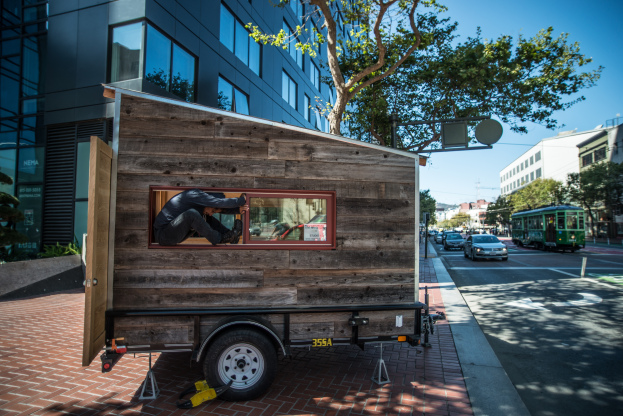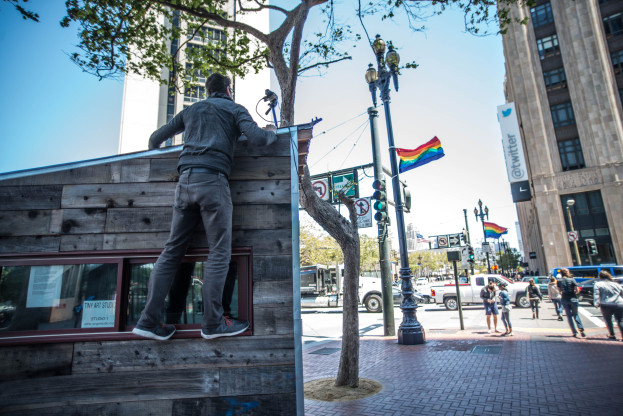Not every year is like 2015. The Supreme Court upheld marriage equality, the Warriors won the NBA title, and we celebrated Anna Halprin’s 95th birthday. The median price of a house in the US was $188,900 compared to median price of a house in San Francisco at $1,115,700. My wife and I welcomed our second child into the world, and after living the better part of this millennium in the Bay Area, we moved.
Our family began to expand in 2011 when our first son was born and it became clear very quickly that working from home in our one bedroom Oakland apartment was going to be tricky. Home became kid land and family focused. At the same time, we intentionally left our full time gigs at Z Space and Intersection for the Arts respectively, to fully commit to our art practice – mine in video and performance, Katrina as a textile artist and author. We needed a place to work that was affordable and nearby.
In response, I designed and built a tiny art studio on wheels to park in the driveway of the house we were renting that could act as a home office. It was funded by a materials grant from the Center for Cultural Innovation and built almost entirely from reclaimed and recycled materials. I called this building Studio 1.
Once realized, Studio 1 expanded from my private workspace to a public art project. I started talking about Studio 1 as “an alternative solution for sustainable art spaces” in the Bay Area. I learned what “urban in-fill” is in developer-speak and how tiny structures could potentially slot into underutilized parcels and help mend the housing crisis in the Bay Area. I expanded my bio to include Social Practice in addition to Performance and Public Art. YBCA invited Studio 1 to exhibit at Bay Area Now7.
The San Francisco Arts Commission took notice, and Studio 1 was invited to deploy along Mid Market Street as a “Living Innovation Zone,” to activate public space, intended to “delight the public.” Together with some visionaries at the Arts Commission and Mayors Office for Civic Innovation, funds were raised, partnerships secured, and permits granted.

It was determined that Studio 1 would be parked at 10th and Market Streets, across from Twitter HQ and also Mechanics Plaza in the heart of SF’s financial district. The contrast between my tiny art space and the gargantuan corporations adjacent was almost comic.
In choosing a group of artists to occupy the studio on Market Street I selected people who could re ect the struggle and complication I was feeling about the Bay Area: Chinaka Hodge, Jose Navarrete, Sara Shelton Mann, Jesse Hewit, Katrina Rodabaugh, Andrea Bergen, Sheldon Smith, Robbie Sweeny, and Shinichi Iova-Koga. Many of these individuals invited other artists to activate the Studio in collaboration. Everyone got paid. All events were free and open to the public. Tens of thousands of people walking Market Street saw art and met the artists responsible. This was last summer, 2015.
Katrina and I had been considering moving back east for several years. We are both originally from western New York state and lived in NY city for stretches of time. We wanted our kids to have a more regular relationship with their grandparents and extended family. We were willing to trade the Bay Area for proximity to NYC. We wanted to buy a house with a barn on the property that we could convert into studio space. Mostly, we wanted to own our home after two decades of renting.
Then, just a few weeks before our second son was born, we bought a 200-year-old farmhouse with barn and several out buildings in New York’s Columbia County. It needed a fair bit of work, but it’s 100 miles directly north of NYC on the Hudson River in a great public school district. Apple orchards border the back of the property and grapes in the front. We had been saving for years, and we finagled financing for a mortgage. Our monthly payments are significantly less than our rent in Oakland. We got the keys in July and moved in October 2015.
I spend a fair bit of time thinking about our move – why we did it, what did we gain, and what did we lose? I also think about the Bay Area arts ecosystem and what it means to have people come and go – or any community for that matter. What is the imprint we leave behind? What is the contribution?
I think about longstanding members of the dance community in the Bay Area: Margie Jenkins, Sara Shelton Mann, Joe Goode, Wayne Hazzard, Amara Tabor Smith, Anna Halprin, Brenda, Kimi and KT (ODC Dance), Alonzo King, Krissy, Keefer Joanna Haigood – hardly a complete list but quickly a dozen people can be named, who have consistently been making dance happen here for 30+ years. Is that typical of a place? Does this consistency give the Bay Area something special?
For me, there is a comfort in knowing these people exist in a community – that there are pillars holding up the fabric, pushing forward, and advocating for us all at a high level. That’s hard to see when you’re living in the middle of it, but it is palpable when you step away.
Now living in rural NY, the community is much more transparent and diffused. The vacancy is significant. But within that open space is an urgency to create – to fill the void, and to build opportunities for myself, my family, and stretch back to connect again to a larger national community. I have plans to be back to SF – also Berlin, Chicago, and NYC. Working remotely still typically requires everyone to assemble in the flesh for performances. Six months into our new life, nding balance is the most challenging concern – how to lay roots and still engage outward.
And while I build a new community and lifestyle here, I wonder if a new generation of long timers is taking hold there. Has the groundwork been set for some folks to persist, or has the current economic pressure become all too burdensome? In 1982 the median price of a home in SF was $124,000 while the national average was right around $78,000. That means it’s about 8x more expensive to buy in SF now compared to 1.5x more in the early 80s. Does that one factor alone determine the staying power of a community? Or can the fabric be held up regardless of this statistic, fortified by leadership, vision, and artistic excellence?
Likely, it is a combination of factors that allows an arts community to thrive in urban centers—a balance of housing, access to rehearsal space, number of producing venues, collaborators, spaces for artists to gather formally and informally, funding opportunities, audience engagement, access to childcare, health insurance, etc.
Ultimately, a tiny house wasn’t a big enough solution for our family needs. Studio 1 is now enjoying a renewed sense of purpose around the Hudson Valley as a pop-up performance and exhibition space in partnership with other institutions locally. Mobility has been elevated to the key asset in a region where cost of space is less burdensome. The old redwood fence board siding always a representation of its west coast roots.

I haven’t yet come to any grand conclusions about the benefits of owning a home in a more affordable, rural area versus renting a home in an expensive urban center. I’m not sure the conversation is that simple: urban versus rural or renting versus owning. But I know that we left the Bay Area at an all time high real estate boom. While we chose to buy a farmhouse, move closer to family, and gain access to great public schools—we also felt forced out.
Ultimately, I’m also trying to stay rooted in the Bay Area—creatively that is—even if I now participate from far away. There’s no simple solution, but I believe that open dialogue about the complications might lead to a better pathway for all of us. Meanwhile, I’m tearing the mildewed drywall out of my old barn so that I can invite performing artists to come stay with us. Make work with us. Take advantage of the resources we can offer from our tiny hamlet in Upstate New York. Because maybe we can’t afford a 3-bedroom house there but we can afford to support artists in the Bay Area from 3,000 miles away.


